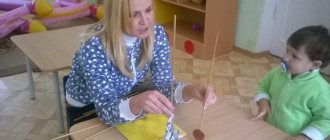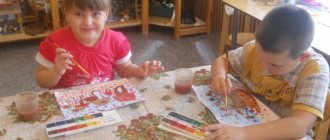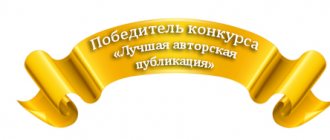Comprehensive and integrated classes in preschool educationconsultation on the topic
Comprehensive and integrated activities in kindergarten.
In the 70s The question arose about intensifying the cognitive activity of school students and overcoming the contradiction of artificial division according to subject matter. The student did not perceive holistically either the educational material or the picture of the world around him. This led to an active search for interdisciplinary connections and their use in differentiated teaching. At the moment, the question arises about using an integrative approach to the education of preschool children and organizing integrated classes. The need for this is explained by a number of reasons.
1. The world surrounding children is known by them in its diversity and unity, and often sections of the preschool educational program aimed at studying individual phenomena of this unity do not give an idea of the whole phenomenon, breaking it up into isolated fragments.
2. Integrated classes develop the potential of the students themselves, encourage them to actively understand the surrounding reality, comprehend and find cause-and-effect relationships, develop logic, thinking, and communication abilities.
3. The form of conducting integrated classes is non-standard and interesting. The use of various types of work during the lesson maintains the students’ attention at a high level, which allows us to talk about the sufficient effectiveness of the lessons. Integrated classes reveal significant pedagogical opportunities, relieve fatigue and overstrain of students by switching to a variety of activities, significantly increase cognitive interest, and serve the development of imagination, attention, thinking, speech and memory.
4. Integration in modern society explains the need for integration in education. Modern society needs highly qualified, well-trained specialists. To meet this need, the training of educated specialists must begin in kindergarten and junior grades, which is facilitated by integration in preschool educational institutions and primary schools.
5. By strengthening interdisciplinary connections, hours are freed up, which can be used for developmental activities of students, as well as additional practical classes.
6. Integration provides an opportunity for self-realization, self-expression, creativity of the teacher, and contributes to the disclosure of his abilities. “The world today lacks its own image, because this image can be formed with the help of a universal system of meaning - synthesis.”
The integrated approach meets one of the main requirements of preschool didactics: education should be small in volume, but capacious.+
In the methodological literature on preschool education there is no clear definition of the features of combined, complex and integrated types of classes; often one is replaced by another or an integrated lesson is confused with a complex, combined one.
NOT. Vasyukova, O.I. Chekhonin give the following characteristics to these types of activities:
Combined - a combination of different types of activities or several didactic tasks that do not have logical connections with each other (after drawing there is an outdoor game).
Complex - the implementation of tasks through different types of activities with associative connections between them (a conversation about fire safety rules turns into drawing a poster on the topic). At the same time, one type of activity dominates, and the second complements it and creates an emotional mood.
Integrated - combine knowledge from different educational fields on an equal basis, complementing each other (considering such a concept as “mood” through works of music, literature, painting).
Preschool childhood researcher N. Gavrish in her book “Modern Occupation” provides a detailed analysis of the process of integration, categorical, semantic, structural properties of modern occupation.
She identifies the following types of classes according to the focus of their content:
unidirectional - subject-specific
multidirectional - integrated and complex classes.
Consequently, complex and integrated classes are multidirectional. The main objectives in such classes are: the comprehensive development of the child, the formation of a holistic understanding of a specific subject based on the integration of different concepts with the involvement of children in different types of activities. However, these types of classes have a number of differences.
An integrated lesson is an activity that is aimed at revealing the holistic essence of a certain topic through different types of activities, which are combined in the broad information field of the lesson through mutual penetration and enrichment.
A complex activity is one aimed at comprehensively revealing the essence of a certain topic through different types of activities that consistently change each other [N. Gavrish / 1, p. 22].
Practical work with definitions. What are the similarities and differences?
Integrated lesson At the stage of preparation for conducting an integrated lesson, to maintain systematic knowledge, educators use the method of intellectual maps or maps of mental actions.
An intellectual map is a structural and logical diagram of the content-procedural aspects of studying a certain topic, which reflects in a radial form the connections of the key concept, which is located in the center, with other concepts of this topic (problem) (together they form an inextricable unity) [N. Gavrish / 1, p. 58].
These maps (schemes for studying a concept or topic) help to reveal the essence of the concept being studied in class and its relationship with other objects (phenomena, processes, objects). The developed map is the basis for further modeling and conducting a lesson or series of lessons (if the topic is very large in scope). This diagram can also be supplemented with specific examples: names of animals, plants, vehicles, diving equipment, sports, and the like. Such cards for the topic can be compiled from prepared material during the lesson with the children. Of course, in this option it is best to use all kinds of images.
Practical work Teachers are divided into 3-4 subgroups and draw up an intellectual map.
The structure of integrated classes requires special clarity, thoughtful and logical interconnection of material from different disciplines at all stages of studying the topic. This is achieved subject to the compact, concentrated use of program material, the use of modern methods of organizing children in the classroom, and interactive work.
It should be noted that conducting integrated classes requires special preparation from the teacher and an already formed stock of knowledge and skills in children on the relevant topic. Therefore, conducting such classes every day is very difficult.
Complex classes Complex and integrated classes are necessarily thematic, in which a selected topic or key concept is the basis for combining tasks from different types of activities.
Consequently, integrated and complex classes provide for the presence of different types of children’s activities, combining knowledge from different fields. But these types of classes differ significantly from one another, although both are based on interdisciplinary (interdisciplinary) connections.
A complex lesson involves the occasional inclusion of questions and tasks from different disciplines and different types of activities. This promotes in-depth perception and understanding of a specific concept. For example, when studying the topic “Spring. Seasonal changes in nature”, the teacher activates children’s knowledge through conversation, accompanying the conversation with children’s drawings and works of artists.
If the main goal of the lesson is to create a holistic image of “spring,” it will integrate content from different disciplines and include tasks with different types of activities. The peculiarity of such an integrated lesson is that blocks of knowledge from different disciplines are combined in order to create a holistic system of knowledge on a specific topic.
It is also believed that the main goal of integrated classes is to create conditions for children to comprehensively consider a specific object, concept, phenomenon, develop systematic thinking, awaken the imagination, and have a positive emotional attitude toward learning.
“In an integrated activity, unification occurs with the penetration of elements of one activity into another, that is, the limits of such unification are blurred. In such an activity it is almost impossible, or at least very difficult, to separate one type of activity from another. In a complex lesson, one activity replaces another, and this transition is noticeable: we’ve drawn, now we’ll play, and then listen to a fairy tale. A complex lesson resembles a multi-layered cake, in which each of the layers remains separate” [N. Gavrish / 1, p. 23].
| Theme "Plant Kingdom" | |
| integrated | comprehensive |
| 1. Solving the crossword puzzle 2.Musical riddles about plants (how the composer conveys the image of a plant, which plant the music suits) 3.Looking at the picture... 4. Map “Plant Kingdom” (generalization, symbols, size, count, quantity) 6.Educational conversation – “The Red Book of Plants” 7.Drawing posters in defense of nature. |
|
Thus
| Integrated | Complex |
| In these tasks, it is difficult to determine which goal is the main one, since they are integrated in nature, allow you to consider the main concept from different angles, and reveal the main properties and features of the object. By completing all these tasks, children systematize their knowledge on the topic “The Plant Kingdom” and have the opportunity to learn something new. | Accordingly, each of the tasks is related to a general topic, but fulfills its specific purpose in accordance with the type of activity: physical - to develop psychophysical properties (speed, endurance, etc.); artistic - to teach how to convey an artistic image using different means of art, etc. And most importantly, by completing these tasks, children’s knowledge on the topic “The Plant Kingdom” is not systematized and most likely is not expanded. |
There are no age restrictions for conducting comprehensive and integrated classes with children. The main thing is the teacher’s ability to organize the work of children in class, the correct choice of the topic of the lesson and its content.
When planning to conduct integrated and complex classes in your work, you should remember that such classes require special training for both children and the teacher. Accordingly, conducting such classes every day is a colossal burden, primarily on the teacher.
When preparing integrated and complex classes, you need to know the basic requirements for planning and organizing their implementation:
- highlight in the program from each discipline similar topics or topics that have common aspects;
- identify connections between similar knowledge elements;
- change the sequence of studying the topic, if necessary;
- take into account specific tasks in the process of studying the topic for each discipline;
- when planning a lesson, formulate the main goal and task;
- model the lesson (analysis, selection, verification) of the content of the lesson, fill it with material that meets the purpose of the lesson;
- identify the optimal load for children (mental, physical, speech activity, etc.).
Practical work. Teachers are divided into two subgroups. One models a complex lesson, the second an integrated one. Introduce each other.
Opinion exchange. Summarizing.
Literature
- N. Gavrish “Modern occupation”
- S.D. Sazhina. Technology of integrated classes in preschool educational institutions. Methodological manual. - M.: TC Sfera, 2008.
- Internet resources
Who is suitable for integrated learning?
The methodology of integrated education comes from a special (correctional) approach to teaching children with disabilities. At first glance, it may seem like a panacea, but this is not entirely true. Integrated education has problems - it is not suitable for all children with inclusion.
Before deciding on integrated education for a child, it is worth showing it to a specialist. He will take into account whether there are external and internal conditions that signal that children are ready for this form of study.
| External conditions | Internal conditions |
| functional disorders were identified at the earliest stages of life | the degree of inclusion does not prevent the child from studying with other children |
| parents are serious about helping their child in the learning process | the child’s abilities allow him to master the curriculum in full |
| there is an opportunity to organize qualified correctional work | the child is psychologically ready for school |
| there are conditions and environment for integrated learning |
If a child has significant deviations in his psycho-emotional and physical condition, then no matter how strong the parents’ desire to educate him in a regular school, in this case it is better to choose a specialized (correctional) class.




